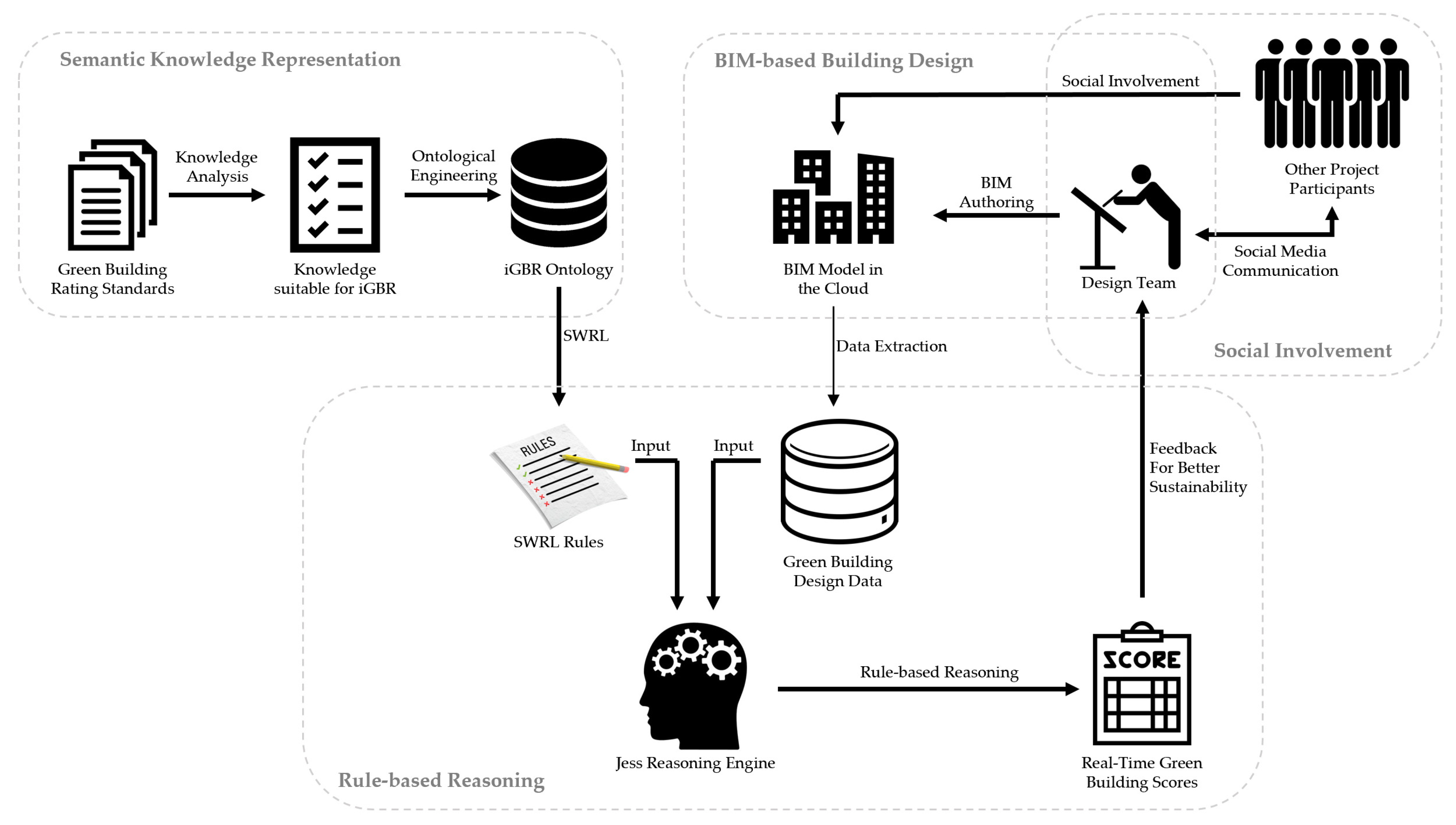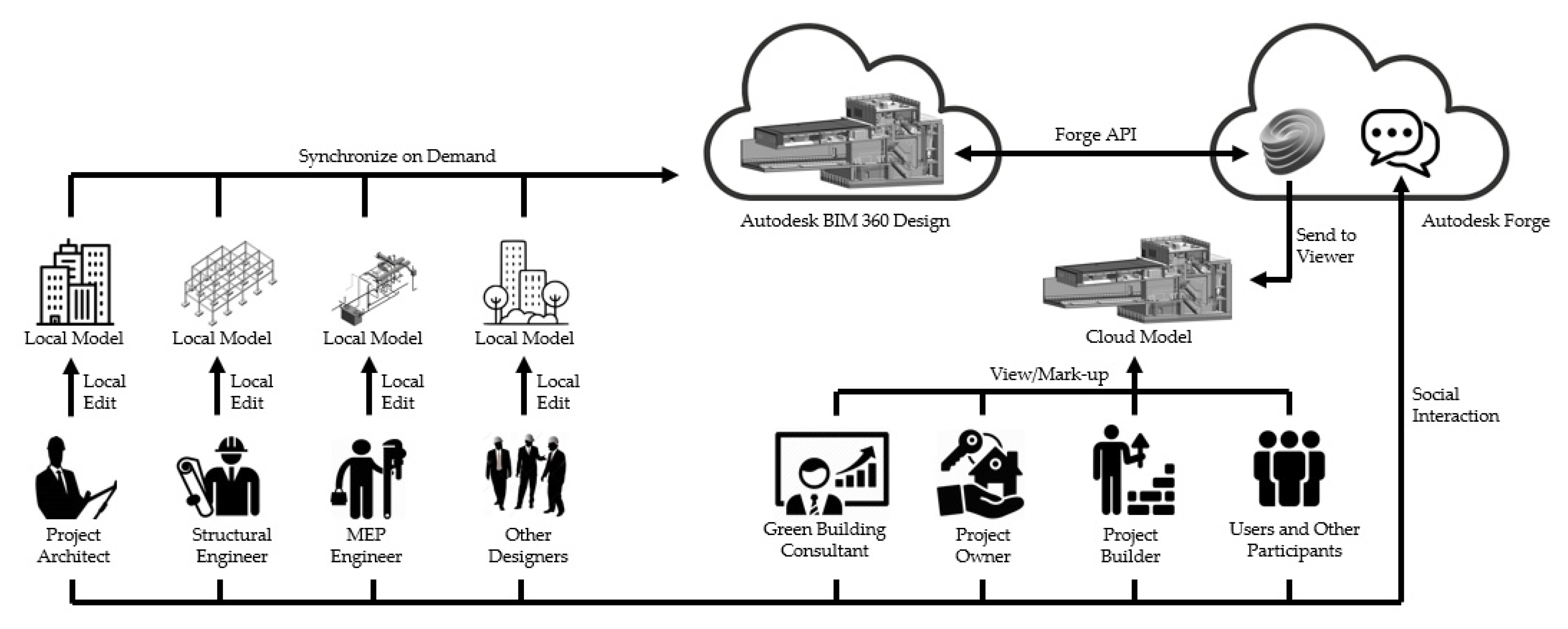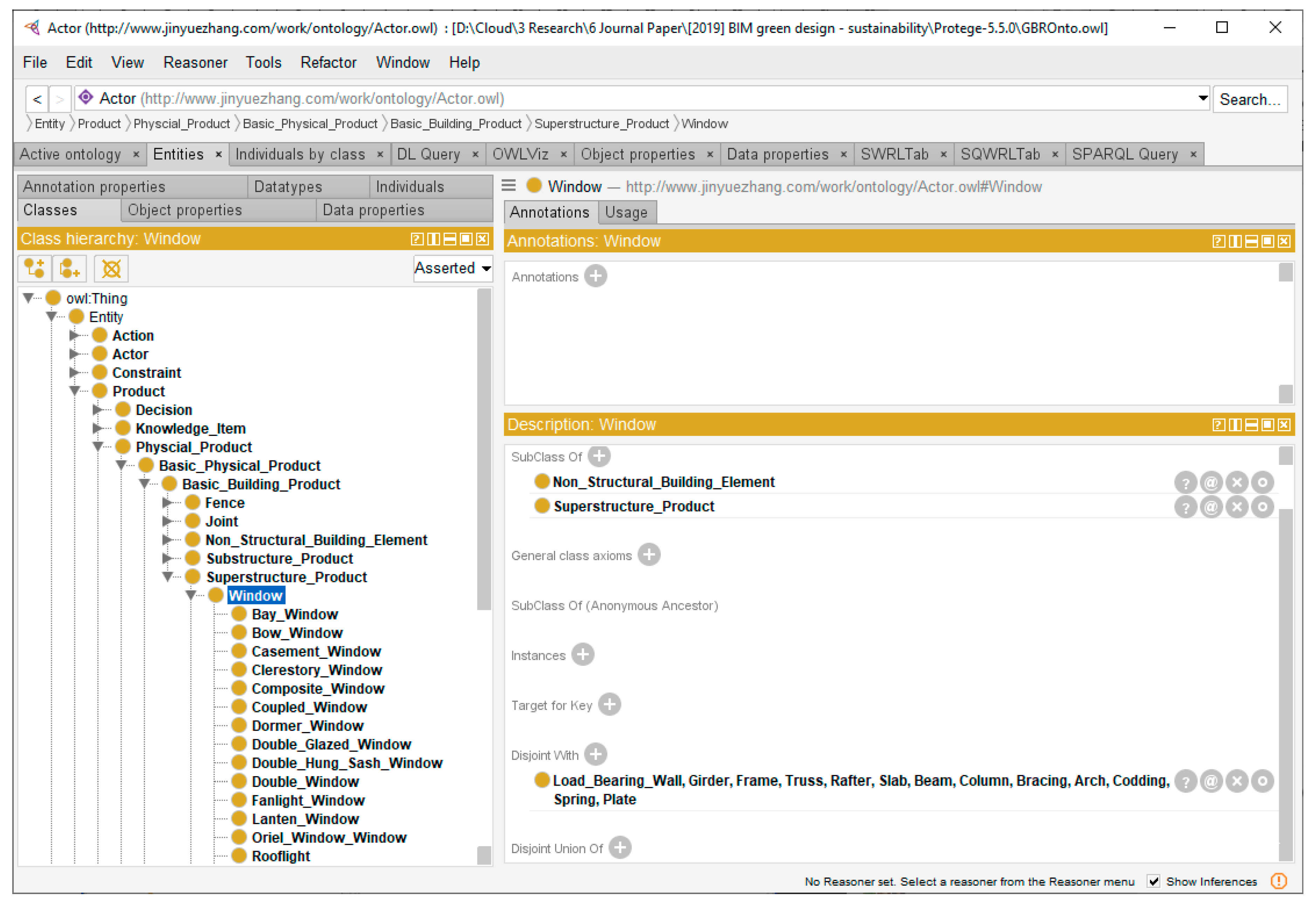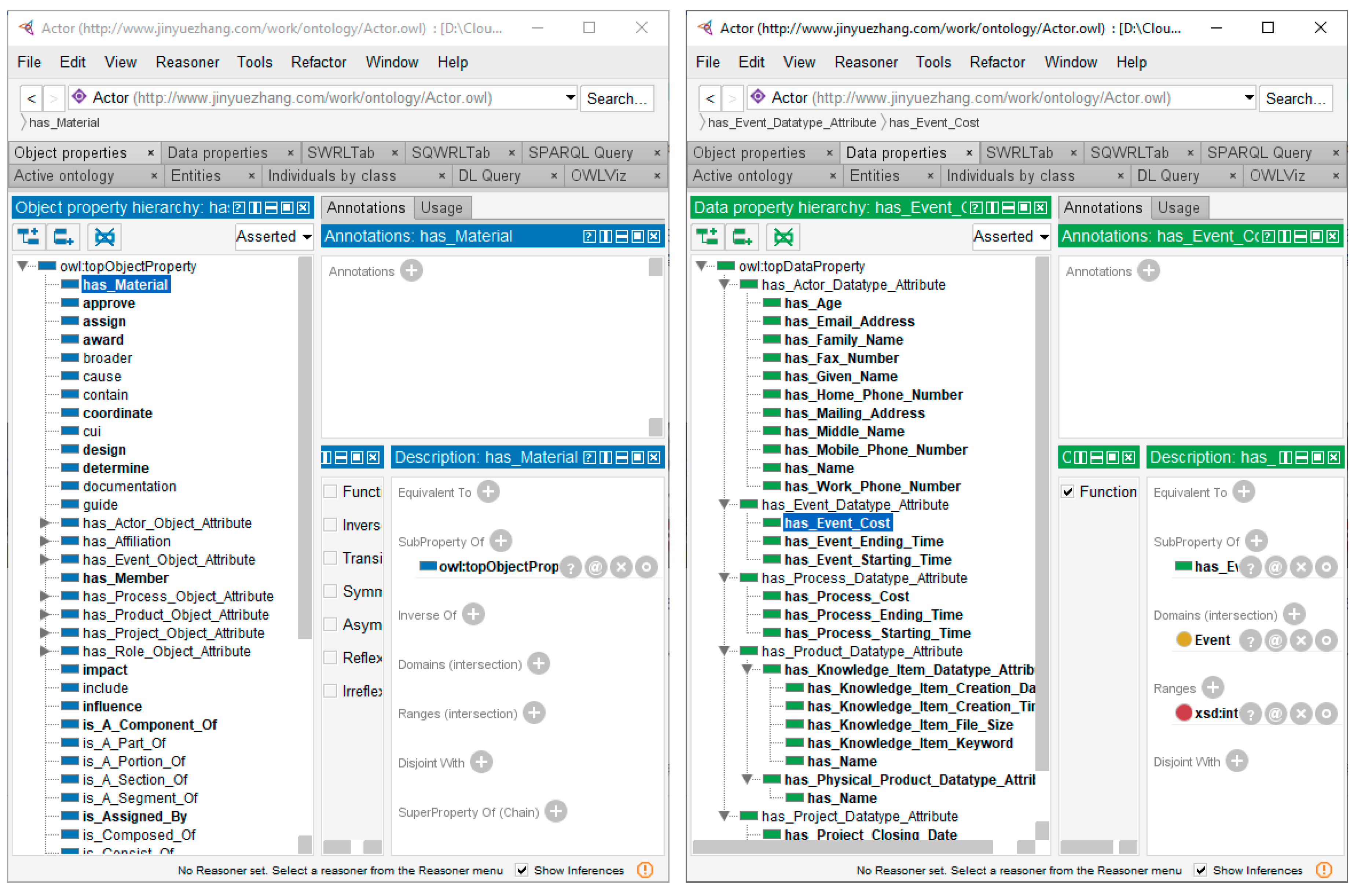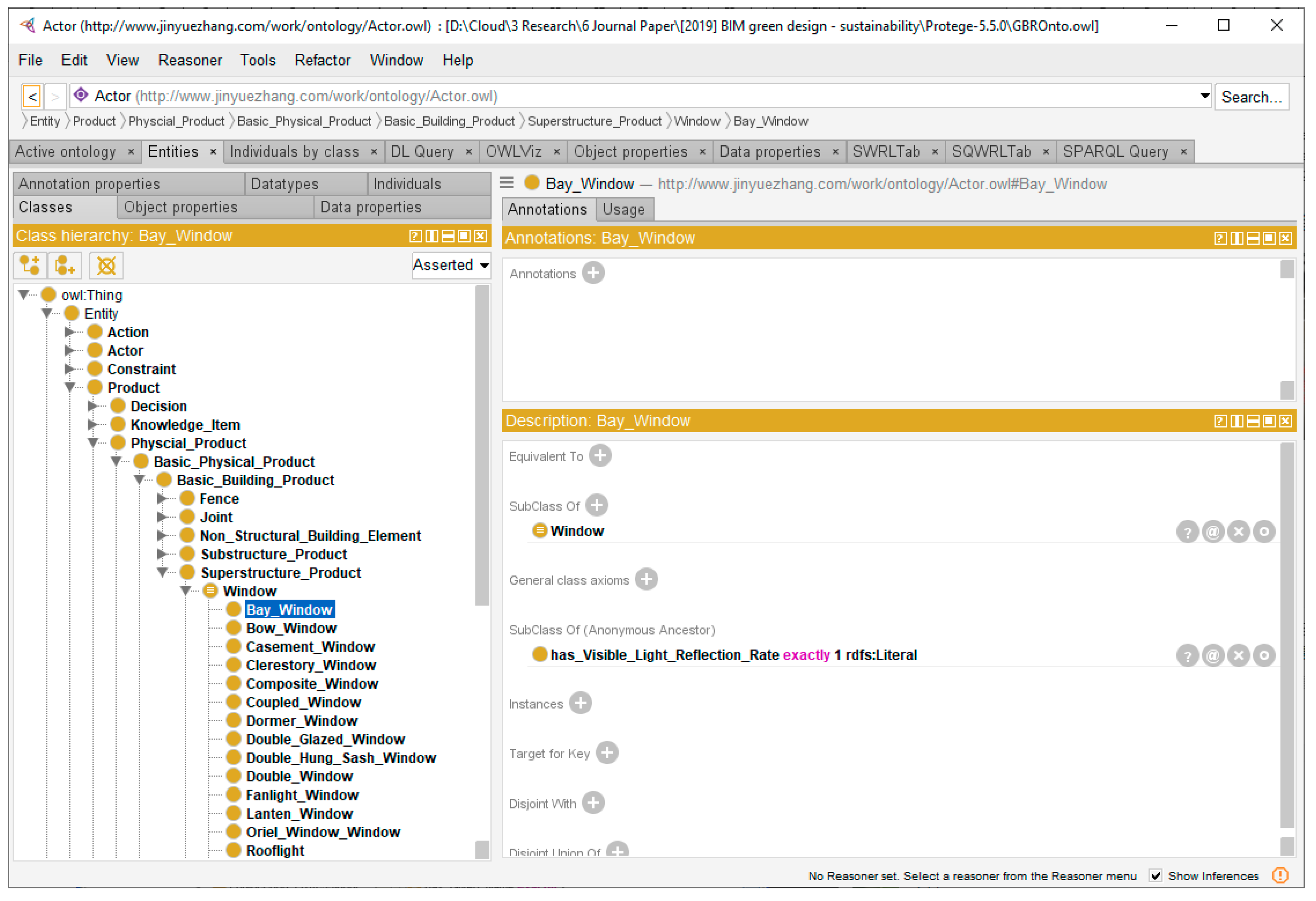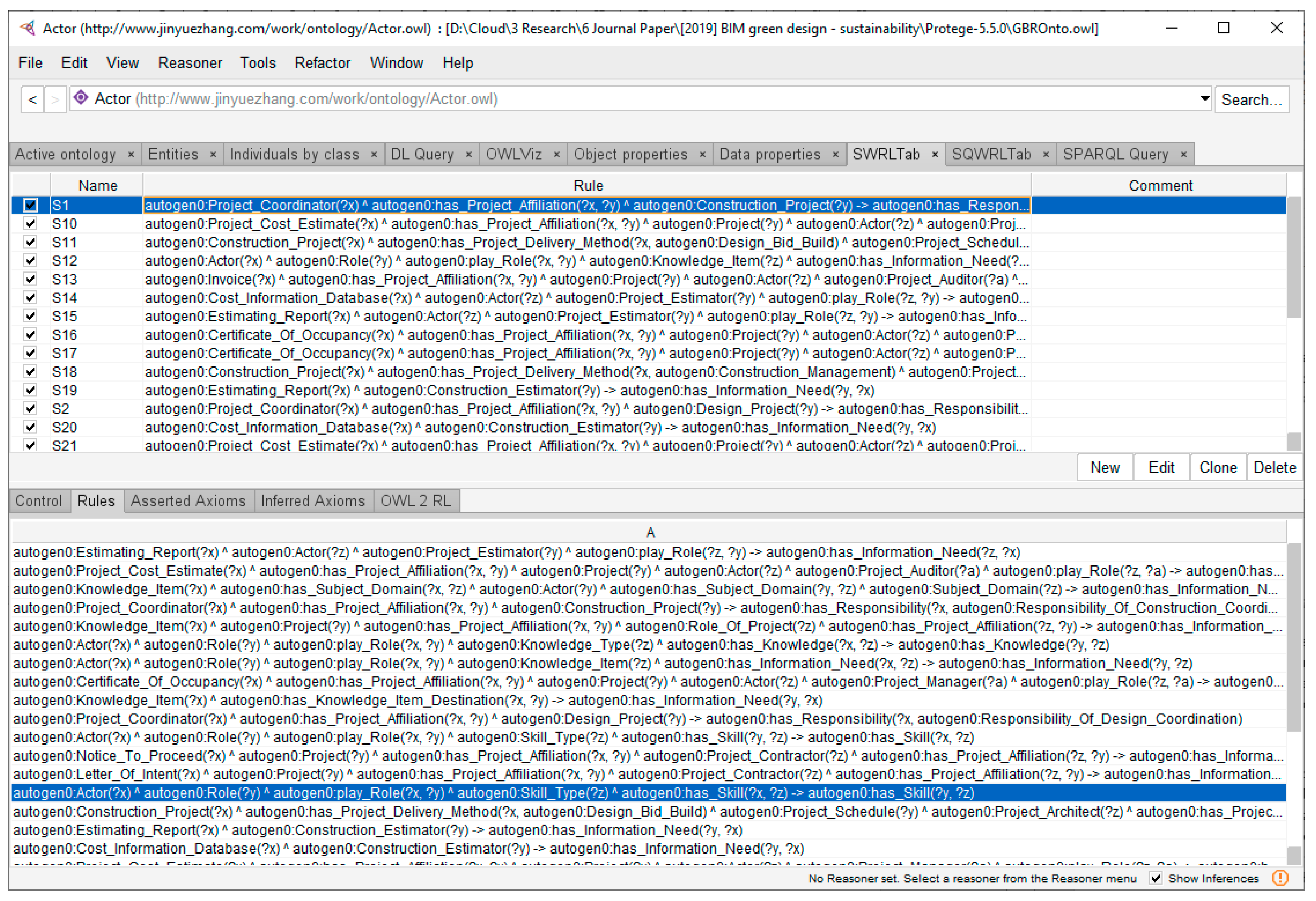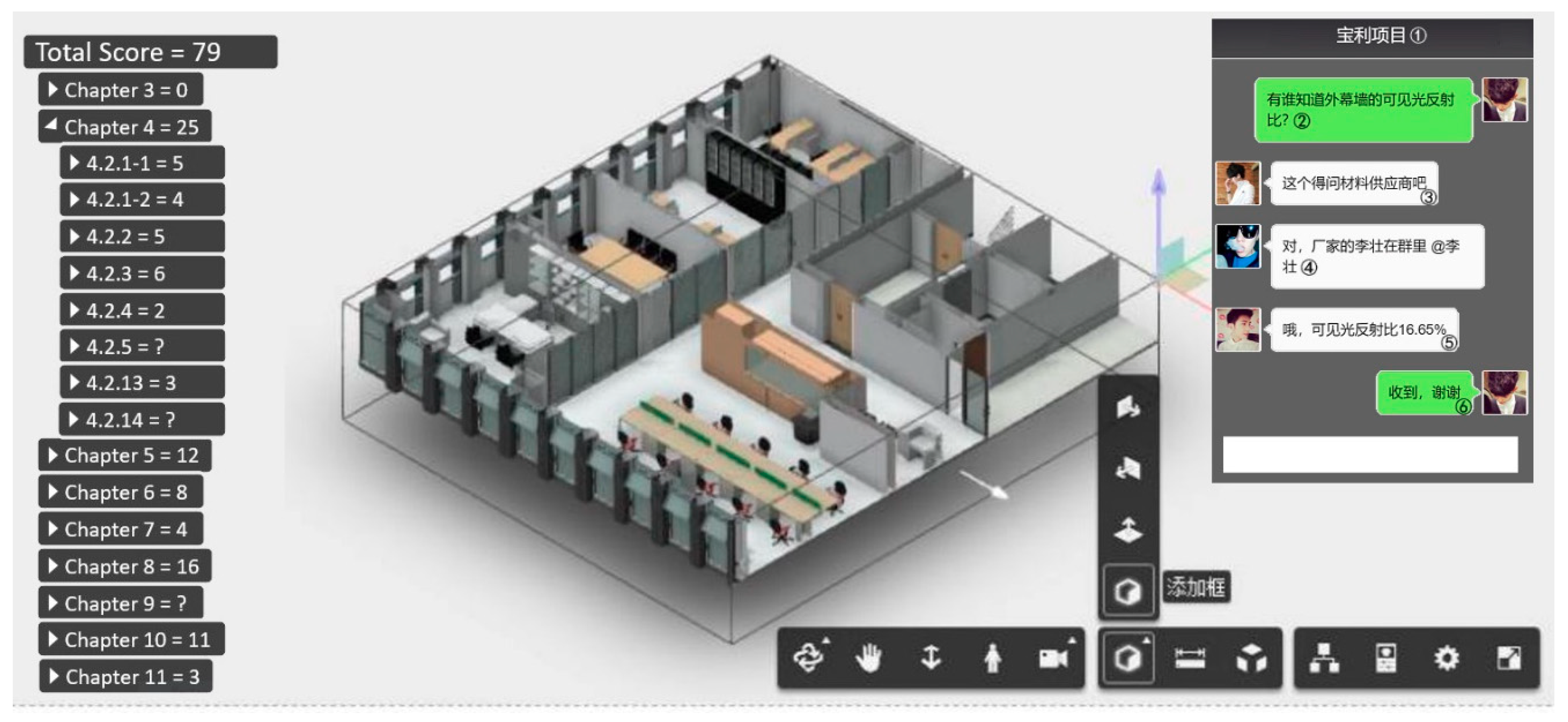1. Introduction
The concept of sustainability is now well acknowledged because of the threats of climate change and global warming, which are fundamentally associated with energy consumption and greenhouse gas emissions [
1]. Buildings (including residential and commercial buildings) play an important role in the energy market. The energy demand from buildings has grown by 1.8% per year in the last forty years [
2], and now the total energy consumption for buildings (mainly for heating, cooling, and lighting) comprises up to 40% of the energy consumption leading to carbon emissions [
3]. It is predicted that building energy consumption will continue to grow worldwide in the coming years to over 184.2 EJ by 2050, which is 50% more than the amount consumed in 2010 [
4]. In addition to direct energy used for building construction, operation, renovation, and demolition, indirect energy is used in the production of building materials and components [
5]. Moreover, building construction consumes a significant amount of natural resources such as wood and stone [
6,
7]; this, in turn, leads to a considerable ecological burden and environmental impacts.
Sustainability in general is defined as “the ability of society to continue functioning into the future without being forced into decline through exhaustion or overloading of the key resources on which that system depends” [
8]. In the construction industry, sustainability means the provision of buildings that use smaller amounts of virgin materials, consume less energy, and produce less pollution and waste [
9]. According to Elkington [
10], sustainability has three dimensions— environmental sustainability, social sustainability, and economic sustainability. For buildings, environmental sustainability refers to the efficient use of natural resources and minimal impacts on the environment, social sustainability refers to the nurturing of social cohesion by providing a safe and healthy built environment, and economic sustainability refers to the lowest life cycle cost that allows the structure to functionally meet users’ requirements [
11].
In order to achieve sustainable buildings (also known as green buildings), many countries have formulated policies and developed green building rating systems (GBRSs) in the last two decades. Two examples are the Leadership in Energy and Environmental Design (LEED) developed by the United States Green Building Council (USGBC) [
12] and the Evaluation Standard for Green Building of China (ESGBC) developed by the Ministry of Housing and Urban-Rural Development (MOHURD) of the People’s Republic of China [
13]. Each GBRS is a collection of articles in different aspects of sustainability. An article is a clause or paragraph to outline a rule or regulation to rate the project in terms of a particular sustainable concern. Those articles are expressed in natural languages which have evolved naturally in humans through use and repetition without conscious planning or premeditation. Natural languages are different from constructed or formal languages that are used in computer programs and logic study, and thus can only be understood by professionally trained people.
Although guidelines and metrics exist for sustainable buildings, the design of sustainable buildings is not a straightforward process. The current mainstream building design practice is a sequential method across different disciplines in decision-making, and no integrated model is used to study different aspects of building sustainability in a systematic way. The multidisciplinary nature of building sustainability requires the consideration of the interdependencies among all architectural, engineering, construction, and operation (AECO) issues, leading to a new level of complexity in searching for good solutions in terms of energy efficiency, instead of applying solutions that are merely feasible [
14].
Many research studies have investigated multidisciplinary interdependencies for green building design. These works are mainly related to computational multi-objective optimization or design collaboration and discipline interaction in the design process [
14]. Wang et al. [
15], Rivard et al. [
16], and Geyer [
17] present mathematical optimization studies that focus on architecture and green buildings that consider energy consumption and project costs. Unlike the approach used in optimization, other studies focus on the interaction of different disciplines in the design process and on collaboration. For example, Fischer and Froese [
18] developed an integrated model to combine applications, allowing a design team to discuss products, processes, and organizational issues. Garcia et al. [
19] employed ontologies to support and improve multidisciplinary collaborations. However, these approaches do not represent interdependencies of sustainability among architecture, engineering, construction, and operation phases in an integrated way to support a better decision-making process.
Building information modeling (BIM) is a model-based technology that provides higher productivity and quality in the building design process [
20]. A BIM model can integrate information on many design, procurement, fabrication and construction, and operation and maintenance practices by defining properties for model components or linking them to an external database [
21]. Because of the ability to accommodate multidisciplinary data, BIM is increasingly employed in research on green building design. For example, Inyim et al. [
22] proposed an extension of BIM, known as Simulation of Environmental Impact of Construction (SimulEICon), to aid in the decision-making process during the design stage to generate optimal options based on construction time, initial costs, and carbon emissions.
BIM can also be used to facilitate green building rating analysis. Azhar et al. [
23] developed a framework to establish the relationship between BIM-based sustainability analyses and the LEED certification process and concluded that, compared to the traditional methods used in rating analysis, BIM-based sustainability software can generate results very quickly and, in turn, save substantial time and resources. In addition to using a BIM model as the provider of multidisciplinary data required for green building rating analysis, Jiang et al. [
24] further developed an ontology to semantically represent the information and knowledge included in the ESGBC, which enables automated rule-based reasoning and intelligent green building evaluation.
Although numerous studies have focused on green building design, none have focused on ways to assist designers to achieve better sustainability during the design process in real time. Currently, green building evaluation is conducted after the design is completed (and sometimes after the building has been in operation for a period of time). Because of this, it is difficult to examine whether the principles and objectives for sustainability are achieved, and it would be too late or too expensive to correct any issues that arise in the construction or operation phases. A real-time green building rating method can also identify more potential ways to optimize the final rating during the design process. For example, in ESGBC, a new real estate development project is given three points when the green land area per capita is between 1.0 m2 and 1.3 m2, and it is given five points when the green land area per capita is between 1.3 m2 and 1.5 m2. If a real-time rating system is available, ideally it will prompt the designer if there is a potential to earn five points instead of three points without much additional cost when the system finds that the current green land area per capita is close to 1.3 m2 (for example, 1.28 m2).
The difficulty of achieving a real-time approach for a green building rating in design lies in three aspects: How to encapsulate knowledge described by natural language in a rating system to support reasoning, how to obtain data and information required to generate ratings in a real-time manner, and how to integrate multidisciplinary information and facilitate the sharing of the information among all members of a design team. This study proposes a semantic and social approach to handle knowledge representation and data/information collection issues in a real-time green building rating system that uses BIM for multidisciplinary collaboration. In the following section, the framework of this semantic and social approach will be described in terms of semantic knowledge representation of green building rating systems, BIM-based building design, social media integration, and rule-based reasoning. A case study is presented to illustrate the development of a prototype for a real-time green building rating system.
2. Framework Development
2.1. Overview
Many GBRSs, such as LEED and ESGBC, are design guide schemes and thus have the potential to support real-time rating and evaluation in the design process. In this research study, an intelligent green building rating (iGBR) framework was developed to provide designers with the ability to evaluate the sustainability level of a building project against a given GBRS in a real-time design process. As shown in
Figure 1, this framework includes four modules—a semantic knowledge representation module, a BIM-based building design module, a social involvement module, and a rule-based reasoning module.
The objective of the semantic knowledge representation module is to represent the knowledge of a given GBRS in a semantic way. Through knowledge analysis and ontological engineering processes, knowledge expressed by natural language in a GBRS is encapsulated in an ontology with rules to determine how the scores are encoded in a Semantic Web Rule Language (SWRL) to support reasoning at a later stage. A design team starts the building design process using some BIM authoring tools (Autodesk Revit, for example) to create digital design models that can be synchronized in the cloud and shared with other project stakeholders, such as building users or material suppliers. The design team will populate values for properties that are required for developing ratings in the BIM model. In cases where some information is missing, the design team will use a social involvement platform such as a Facebook group to consult with all project stakeholders, and any project participant can directly contribute his/her knowledge to the cloud-based BIM model. Data required for the green building evaluation are extracted from the BIM model, combined with SWRL rules from the ontology, and exported to a reasoning engine. The reasoning engine will automatically calculate real-time scores based on the GBRS and the current design. Using the scores as feedback, the design team can improve the design if necessary, and the updated design will be instantly re-evaluated by the iGBR system.
2.2. Semantic Knowledge Representation of GBRS
Recognizing the importance of building sustainability, authorities and organizations across the globe have initiated different GBRSs to minimize or optimize the consumption of energy and natural resources. Compared to the full spectrum of sustainability in environmental, social, and economic aspects, GBRSs mainly focus on the environmental aspects [
25]. Buildings that can achieve good scores are certified and are considered to be “environmentally friendly” buildings [
26].
The first GBRS to be released is the Building Research Establishment Assessment Method (BREEAM), which was developed and is operated by the Building Research Establishment (BRE) in the United Kingdom [
27]. Since its introduction to the market in 1990, BREEAM has had a great influence on later GBRSs such as LEED, ESGBC, the Green Star system in Australia and New Zealand, the Comprehensive Assessment System for Building Environmental Efficiency (CASBEE) in Japan, Canada’s LEED Canada, Hong Kong’s Building Environmental Assessment Method, and Singapore’s Green Mark Scheme.
China and the United States are the top two countries in the energy market in terms of energy consumption [
28] and global CO
2 emissions [
29]. The first version of ESGBC was released by the MOHURD in China in 2006, and the current version is GB/T50378-2014 (effective 1 January 2015) [
13]. As a GBRS, ESGBC covers more aspects of sustainability, including land use and outdoor environment, energy, water, materials, indoor environment, construction management, building operation, and innovation [
13]. In the USA, building energy policies are managed at both the federal and the state levels, where the federal government sets appliance standards, provides financial incentives, and sets policy regarding any required labeling, while local governments are responsible for creating building energy codes and providing optional extra incentives [
30]. USGBC developed LEED to evaluate the level of sustainability of buildings using a set of rating systems for the design, construction, and operation and maintenance of a building [
12].
An ontology is the formal conceptualization of knowledge in a given application domain [
31]. As a commonly agreed-upon standard, ontologies provide knowledge content with both syntactic (structural) and semantic (contextual) information. The use of ontologies in the construction industry mainly covers three perspectives: interoperability improvement between software tools [
32], knowledge management within or across domains [
33], and logical reasoning and proofs [
34]. A green building rating ontology (GBROnto) serves as the semantic knowledge representation in this proposed framework to formally encapsulate knowledge of a given GBRS as well as the building blocks for SWRL rules.
Different knowledge representation paradigms are employed for developing ontologies. In the last decade, description logics has become a popular knowledge-representation paradigm and, along with the increased attention paid to the Semantic Web, some description logic languages such as Web Ontology Language (OWL) have dominated the field [
35]. Broadly speaking, four basic components are required to represent domain knowledge [
36]:
classes, which are major domain concepts;
relationships, which are used to represent associations;
axioms, which are statements that are always true in the given domain; and
instances, which are individuals of domain concepts.
A number of methods for developing ontologies have been reported. There is no single correct methodology that fits all development projects, and there is no one methodology that is superior to another. The selection of one or another method relies entirely on the characteristics of the ontology to be developed. Gómez-Pérez et al. [
36] have summarized several methodologies with a significant influence on ontology development. From these, the methodology of Grüninger and Fox [
37] has been adopted in this study, because it covers relatively more ontology development activities than most other methodologies.
In general, ontology building involves three steps—taxonomy building, relationship modeling and axiom identification. These three steps will be used to develop three of the four components mentioned earlier for representing domain knowledge. The last component,
instances, will be populated in the ontology when it is applied in a real case. While it is vital to develop new ontologies from scratch, it is equally important to reuse existing basic ontologies. For example, ifcOWL ontology [
38] is an effective OWL representation of building data that is recommended by the building SMART alliance
®, a major non-profit organization that provides international standards for BIM data, including Industry Foundation Classes (IFC) [
39]. Both ifcOWL data and IFC data are semantically structured and, thus, some classes and relationships can be directly translated to GBROnto by simply changing the syntax.
2.3. BIM-Based Building Design
In recent years, researchers have acknowledged the importance and effectiveness of using information and communication technology such as BIM to facilitate the integration of sustainability in the building design process, since previous attempts are mainly organizational approaches that have resulted in generic descriptive models of the design process and that do not integrate sustainability considerations into the technical design activities [
40]. Although the adoption of BIM in the building design community has increased greatly in the last two decades, BIM-based design remains fragmented in many cases rather than collaborative [
41]. The reasons are twofold: (1) The construction industry has a fragmented nature in terms of project delivery [
42] and (2) software interoperability is still a big issue to bridge information islands among different processional domains. In order to better serve the goals of green building design, BIM-based design requires an environment where all project participants are engaged and information is collected, managed, and shared in a timely manner. This approach would ensure that the right information is available to the right person at the right time in order to support optimal design decisions.
An online cloud-based BIM collaboration environment is the infrastructure of this proposed iGBR framework. In order to support green building design, this online collaboration environment should link not only members of the design team but all project stakeholders, because some information required for the green building rating originates from a party outside of the design team, for example, a construction material supplier or producer. Although sharing BIM data across different design platforms (such as between Autodesk Revit and Bentley AECOsim Building Design) is not easy, major BIM software venders have established a relatively complete design environment within one platform for multi-professional collaboration. One example is Autodesk BIM 360 Design, which enables a design team to co-author a Revit model in real-time across different professions within one firm or multiple firms. For the purpose of collaborating with project participants who are not a part of the design team, the ease of information access and communication is the first priority, as participants may have no professional skills to operate a BIM authoring tool and/or they do not have a budget for BIM software. For these people, model updating could be an “on demand” feature, and real-time synchronization is not needed.
Autodesk
BIM 360 Design and Autodesk
Forge are integrated in this research to create an online cloud-based collaboration environment to support iGBR framework. As shown in
Figure 2, Autodesk
BIM 360 Design is a real-time design collaboration platform for a project design team. A project architect creates a
Revit model and then initiates collaboration in the
BIM 360 Design platform. Any designer on the design team will be able to work on his/her domain based on the latest model in the cloud platform. The design can be synchronized on demand to the cloud to form a federated design model with the work of other designers. This federated model is then captured by a
Forge application program interface (API) to be sent to Autodesk
Forge. Autodesk
Forge is a platform of web service APIs that allow people to integrate Autodesk products such as
BIM 360 Design into their workflows and/or to embed some of the components used in those Autodesk products into their own web or mobile applications. The
Forge platform is used in this environment for two reasons. First,
Forge Viewer is used to visualize the federated model in a web browser. This is an important function for project participants outside of the design team, as it allows green building consultants, project owners, and project builders to view the design without having to use a BIM authoring tool. Second, the
Forge platform allows customized functions to be realized through secondary development. The social media communication shown in
Figure 1 is a function similar to a group chat in
Google Hangouts, where all project participants can discuss green building design issues and share information (see
Section 2.4 for more details).
2.4. Social Involvement
Social involvement is an innovative approach used in this research to harvest the collective intelligence of people in all participating roles in sustainable building design. The term
collective intelligence refers to shared or group intelligence that emerges from the collaboration of many individuals and appears in consensus decision making [
43]. In this research, collective intelligence represents the overall knowledge of how to design, build, and maintain/operate a sustainable building, as well as to meet the demand from building owners and users for sustainable buildings. The “social web” (also known as “Web 2.0”, which supports applications such as
Twitter and
WhatsApp), combined with a faster and cheaper mobile Internet infrastructure, helps individuals and groups to share knowledge through collective platforms. Collective intelligence is a great resource for helping human communities evolve their collective capabilities in an unprecedented way [
44].
Social involvement in planning, designing, and assessing the built environment is not a new concept and has attracted attention in academia and practice for more than 40 years [
45]. The recent interest in social involvement, especially during the planning and design phases, has shifted from power distribution to the collection of valuable knowledge [
46], where building users are viewed as active participants and co-creators of products and not just as consumers [
47]. Tzortzopoulos et al. [
48] and Nilsson et al. [
49] identified good examples of social involvement in the healthcare sector in the UK and Sweden. Göçer et al. [
50] explored a way to engage different building stakeholders in a collaborative effort of continuous building performance evaluation in the post-occupancy phase. Jung et al. [
51] proposed a sustainable situation-awareness supporting framework that involves the aggregation of service-specific knowledge from online health communities to support better decision making.
Early studies have demonstrated that general users have difficulties in exchanging information with professional people because of the lack of a specialized background and vocabulary [
52]. Thanks to the fast-developing technology, the use of various facilitation methods and visualization tools, such as BIM and virtual reality, has greatly improved the efficiency of knowledge communication.
The social involvement method employed in this research has two features – online visualization of a BIM model in a browser and a social media approach in communication. As mentioned in the previous section, one of the major advantages of using BIM in design is to visualize 3D space as well as certain digital parameters (such as stress in a structural design). Presenting a BIM model online in a Web browser allows participants not only to quickly understand the content of the information being communicated—especially for non-professionals such as members of the general public who will use the building—but also to access the information at any time or place. As people are already familiar with social media tools such as WhatsApp, the communication interface in this research was designed to incorporate similar features: For example, people working on the same project are placed in a group and an “@” symbol can be used to notify a particular person. This easy-to-use social communication platform can assist the design team in soliciting input from all stakeholders, enabling designers to receive real-time feedback from peer designers and to obtain missing information.
2.5. Rule-Based Reasoning
The ability to produce a rating in real time during the design process, which is the most appealing feature of this proposed framework, is supported by automatic rule-based reasoning. Simple axioms are coded in an OWL file by defining restrictions in the ontology. For example, “any screen wall glass has a property called visible light reflection rate” or “any visible light reflection rate has one and only one positive value”. As the reasoning ability of OWL is limited, any complex reasoning processes that arise in this study are handled by SWRL.
SWRL is a proposed language for the Semantic Web. Because of its built-in arithmetic and Boolean operations, when combined with OWL, SWRL can be used to express both rules and logic, which means that it will have sophisticated constraints and powerful reasoning ability [
53]. An SWRL rule is expressed in “if A, then B” format [
54], where both A and B could be the conjunction of atoms (as shown in Function (1)) and an atom is a predicate in OWL (as shown in Function (2)).
where
p is a predicate term defined in OWL and
arg1,
arg2, …,
argm are the terms or arguments defined in that predicate expression. Atoms in these rules can be in the form of
C(x),
P(x,y),
sameAs(x, y) or
differentFrom(x, y), where
C is an OWL class description,
P is an OWL property, and where
x,y are either variables, OWL individuals, or OWL data values. For example, one rule in ESGBC states that, given a residential project, if the total area of windows of all living rooms and bedrooms is greater than 20% of the total area of the floor space of those rooms, the score of Article 8.2.6 is 8. This rule is expressed in SWRL as shown in Function (3).
where x is the building to be assessed, wa is the total area of windows, fa is the total area of floors, far is 20% of fa, and hasScore8.2.6 is one of properties of x which represents the score of article 8.2.6 in ESGBC.
As shown in
Figure 1, the ontology “GBROnto” represents the knowledge of green building assessment in China, and the rules are expressed in SWRL. At the same time, the real data in the BIM model that are extracted are considered to be complete when using the
BIM 360 Design platform and the social involvement approach and are also considered to be sufficient for green building assessment. At this point, SWRL rules and data facts need to be processed in a reasoning engine to calculate the real-time assessment scores for all articles. A rule engine for the Java platform, known as “Jess”, is selected as the reasoning engine in this research study, as it can transform OWL ontology into Jess facts and transform SWRL rules into Jess rules [
55]. The new knowledge generated from the logic reasoning process is translated into green building assessment scores, and the design team can adjust the design based on the score feedback to ensure the sustainability of the building project.
4. Conclusions
Buildings consume a large amount of energy both during the construction phase and the operation phase. In order to promote the concept of sustainability, many countries developed GBRSs as guidelines for green building design. However, in some cases, it may be difficult for designers to achieve better sustainability in the design process when using a green building rating score as a reference. The iGBR framework proposed in this research employs a semantic and social approach to realize a real-time rating for the building design. First, an ontology is used to encapsulate the knowledge of a green building rating system. Second, a Jess reasoning engine and SWRL rules are used to calculate green building rating scores. Third, Autodesk Forge is chosen as a BIM-based design platform to synchronize the design models of different professions in the cloud. Lastly, a group chat tool connects all project participants in a social communication environment to exchange data/information required for calculating the score. The prototype iGBR system developed based on the ESGBC can assist designers to calculate green building rating scores for 95 articles in a real-time approach.
The proposed iGBR framework can be easily adapted for use with different GBRSs. Because an ontology is used to encapsulate domain knowledge of a green building rating, the calculation rules are encoded in SWRL but are not hard-coded into the iGBR system. When there is a need to conduct real-time green building assessment against another GBRS (such as LEED, for example), one can simply develop an ontology and the associated SWRL rules based on the method mentioned in
Section 3.1 and
Section 3.2 and reuse the application developed in
Section 3.3. This process is also applicable to a situation where a newer version of a given GBRS is released. For example, China has released an updated version of ESGBC that is effective on 1 August 2019. The GBROnto developed in this research can be upgraded to a new ontology based on changes in ESGBC, and the SWRL rules can be updated as well. In short, this iGBR framework separates the knowledge and the system functions, making it more flexible in conforming to different standards.
It should be noted that this iGBR framework is not able to handle all articles of a GBRS and give the complete score of a project, but only partial articles that can be represented in an ontology and expressed in SWRL rules. One option to extend this iGBR framework, so that it can include all articles in a GBRS is to further develop a manual module where the scores of some articles can be manually calculated outside the system and then entered into the system to generate a complete green building rating score for the entire project.
Another potential application of the proposed iGBR framework is a function that would provide smart recommendations. At present, a green building rating score is calculated based on the SWRL rules and the design facts from the BIM model. In some cases, a project could be given a better score with a small improvement because most GBRS articles determine scores in tiers. For example, the Article 5.2.2 in ESGBC says, if a building has a screen wall but not external windows, the project is given four points if the openable portion is greater than 5% and six points if the openable portion is greater than 10%. In a particular design, if the openable portion is 9% and based on the ESGBC, the project is given four points in this article. However, if the system can see the possibility of gaining two additional points with a small change and can recommend this change to the design team, the project is very likely to obtain a better score. Obviously, the threshold when a recommendation is proposed is a number that needs to be determined in an intelligent way.
